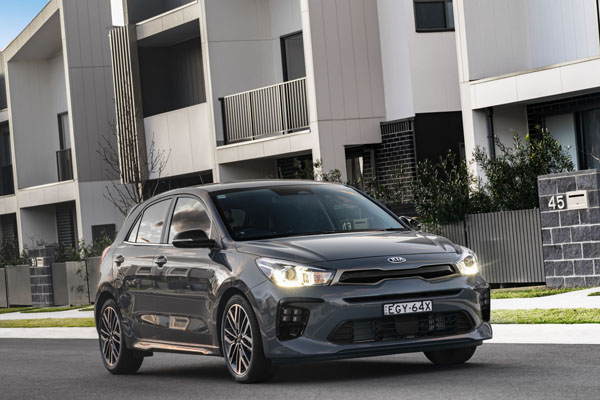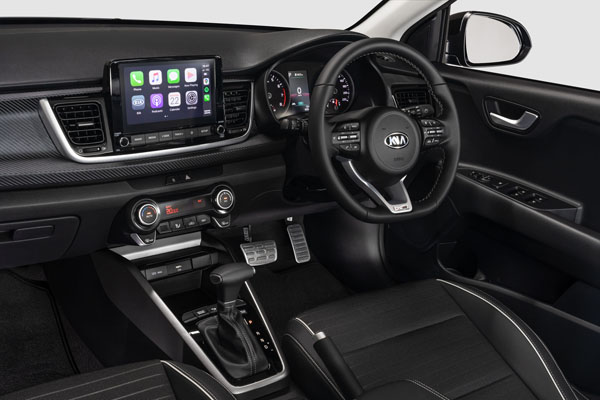
As fuel costs seem to be up and down almost on a daily basis and there’s the continuing anxiety about COVID-19 quite a few people are moving down in car size and price. Kia Rio is one of those that appeal to them so we’ve just spent a week in one to get a feel for it.
Significant upgrades of the popular Kia small car, with a strong emphasis on technology and infotainment are intended to give it an even better position in this hard-fought sales arena.
STYLING
The updated Rio has a refreshed front design that, of course retains the car’s iconic ‘tiger-nose’ grille along with a lower, wider front bumper and distinctive new foglight housings.
Two new exterior colours are also introduced for the GT-Line Perennial Grey (also available on Sport trim) and Sporty Blue, bringing the total number of colours to six for the S trim, seven for Sport and six for the GT-Line. Our test car had the Sporty Blue, which seems sure to appeal because blue is one of the fashionable shades of the moment.
INTERIOR
Kia Rio Sport and GT-Line models have a new 4.2-inch colour cluster displaying all the important driver information in one central location.
INFOTAINMENT
There’s a strong emphasis on infotainment in this midlife change, which makes sense as the Rio is aimed at younger buyers who are more interested in sound output than exhaust notes and snappy handling. It now has a larger 8-inch audio-visual multimedia unit that in the original model.

We found sound quality to be pretty good and we had less trouble picking up distant radio stations than in many other test cars. Of course signals vary from day to day, in fact minute to minute, so accurate comparisons are not possible.
There’s now wireless Android Auto and Apple CarPlay connection, eliminating the previous need for cable connection.
ENGINES / TRANSMISSIONS
Power comes from a 1.0-litre three-cylinder turbo-petrol unit. It peaks at 88kW and there’s 172Nm from 1500rpm to 4000rpm. Meaning that top torque is likely to be always under the right foot of the typical person who choses cars in this class.
Drive is to the front wheels via a seven-speed double-clutch automatic. While a manual is offered on the others in the Rio range the GT-Line doesn’t have have this option.

SAFETY
All important safety items are there in every Rio variant. Autonomous Emergency Braking (car, pedestrian, cyclist). The Sport and GT-Line will gain Forward Collision Warning; Lane Keeping Assist; Driver Attention Alert (where driver steering inputs and patterns are monitored using cameras and sensors with an audio/visual warning issued if careless driving is detected) and High Beam Assist.
The GT-Line models have full climate control, there’s a clever Automatic Window Defogger which operates whenever the climate control system is on.
DRIVING
There’s good engine response in Sport and turbo lag isn’t overlong. We found it way too slow to react in Normal and Eco modes, to the extent we had it in Sport for virtually our entire week. A bonus of Sport is that there’s rather a nice engine note.
The auto was generally in the right gear almost all of the time and was happy to change down when it sensed more grunt was needed.
Fuel consumption around town was higher than expected at eight to nine litres per hundred kilometres, but see our note about using the Sport mode most of the time.
Good steering feel and quick response will please keen drivers. Kia’s use of Australian and Korean suspension tuners has proven excellent over the years and seems to make each new model, or even a facelifted one just that little bit better.
The semi-sport seats have side bolsters but are rather narrow, I fitted but anyone broader in the beam wouldn’t have been happy – test before you buy. They are a bit too firm and I’m not sure I would like to do long country trips, to be fair it’s a city car.
Room in the back seat isn’t bad in the back for a car of this size. You will probably need to share leg space if someone tall is back there.
The Korean company’s 7-Year Warranty, 7-Year Capped Price Servicing and 7-Year Roadside Assist package really impresses potential buyers.
SUMMING UP
Kia Rio GT-Line is not a full-on sports model but it provides the sort of driving feel Aussies love at a very modest price.
AT A GLANCE
MODEL RANGE
Rio S 1.4-litre petrol five-door hatch: $18,990 (manual), $19,990 (automatic)
Rio Sport 1.4-litre petrol five-door hatch: $20,990 (manual), $21,990 (automatic)
Rio GT-Line 1.0-litre turbo-petrol five-door hatch: $24,490 (automatic)
Note: These are drive-away prices and include all government or dealer delivery charges.
SPECIFICATIONS (Kia Rio GT-Line 1.0-litre turbo-petrol five-door hatch)
ENGINE:
Capacity: 0.998 litres
Configuration: Four cylinders in line
Maximum Power: 74 kW @ 6300 rpm
Maximum Torque: 172 Nm @ 1500 rpm
Fuel Type: Standard unleaded
Combined Fuel Cycle (ADR 81/02): 5.4 L/100km
CO2 Emissions: 125 g/km
DRIVELINE: Seven-speed automatic
DIMENSIONS, WEIGHT AND CAPACITIES:
Length: 4070 mm
Wheelbase: 2580 mm
Width: 1725 mm
Height: 1450 mm
Turning Circle: 10.2 metres
Kerb Mass: 1176 kg
Fuel Tank Capacity: 45 litres
BRAKES:
Front: Ventilated disc
Rear: Solid disc
STANDARD WARRANTY:
Seven years / unlimited kilometres











